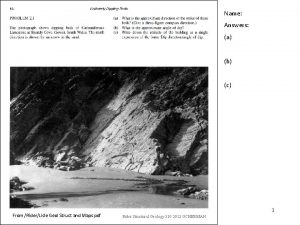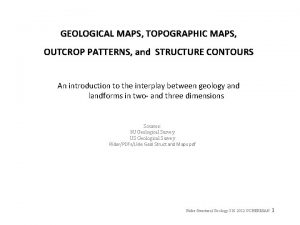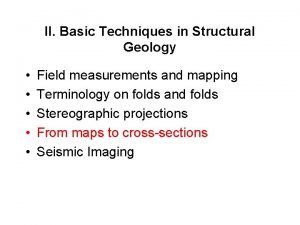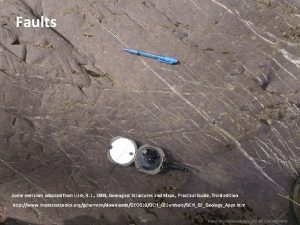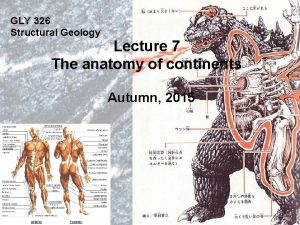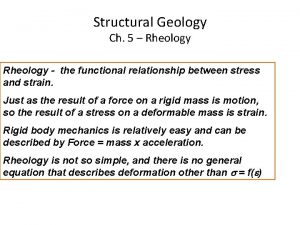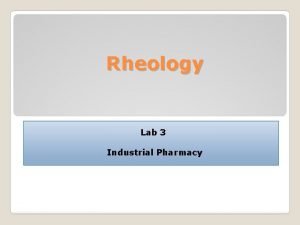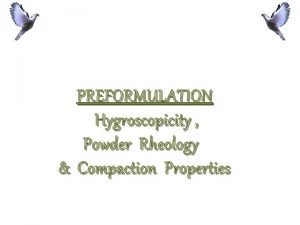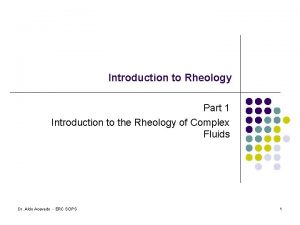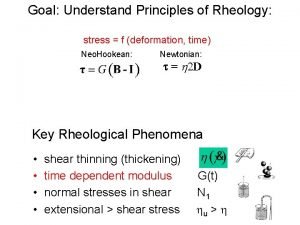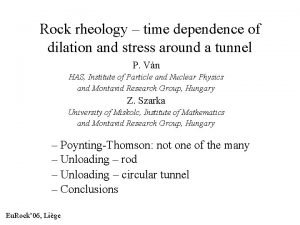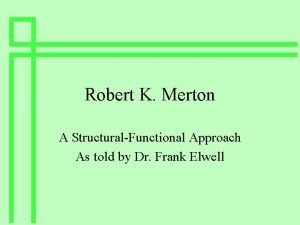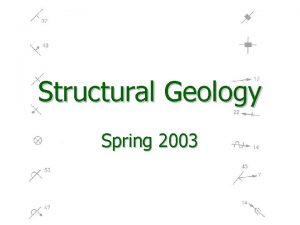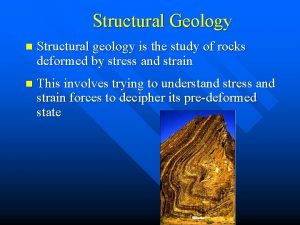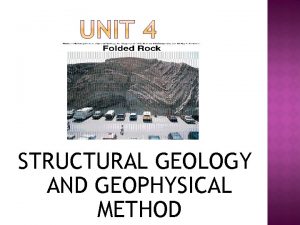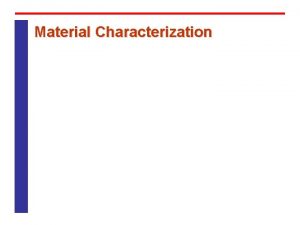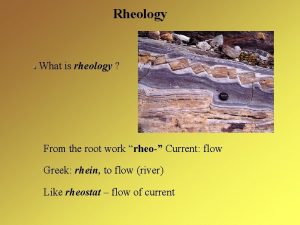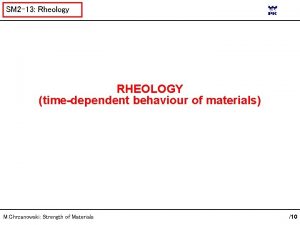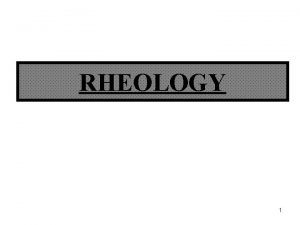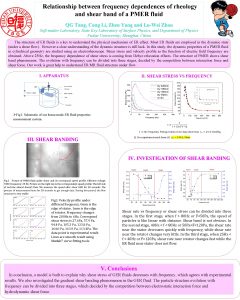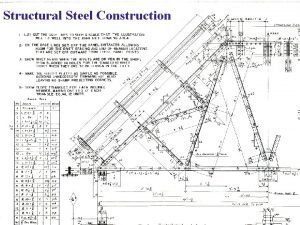Structural Geology Ch 5 Rheology the functional relationship












































- Slides: 44

Structural Geology Ch. 5 – Rheology - the functional relationship between stress and strain. Just as the result of a force on a rigid mass is motion, so the result of a stress on a deformable mass is strain. Rigid body mechanics is relatively easy and can be described by Force = mass x acceleration. Rheology is not so simple, and there is no general equation that describes deformation other than s = f(e)

Compression, tension and shear forces stress the rocks, causing them to strain i. e. “give” Units of Stress = Force / Area Convergent Divergent Transform

Relation ship Between Stress and Strain Rubber Band Strain can be a change in shape (a deformation) due to an applied stress

Relationship Between Stress and Strain at low Temps and Pressure or Sudden Stress Ruler, Pencil

Relationship Between Stress and Strain under high Temps or Pressure Chewing Gum

Structural Geology (3443) Ch. 5 – Rheology Determination of the functional relationship s = f(e) must be done experimentally and that sub-discipline is called Rock Mechanics. Rock mechanics is most important in engineering geology, where the stability of slopes, tunnels, mine adits, shafts drifts, and soils and foundations determines the economic viability of a project and the health of the users. In Structural Geology and Tectonics, experimental rock deformation is important in determining the evolution of natural structures and tectonic features.

Structural Geology Ch. 5 – Rheology Design of triaxial compression testing equipment is shown at left. tress is increased vertically by hydraulic jack. Confining stress on sides is produced independently by fluid pressure. Pore pressure (fluid pressure in pore space) is produced the by using the natural fluids (water, petroleum). Temperature is also controlled.

Structural Geology Ch. 5 – Rheology Vertical stress on the specimen is calculated knowing the force on the piston and the area of the specimen top. Here vertical stress is usually the maximum stress (s 1) Stress on the side of the specimen is the same as the confining fluid pressure. Since the two side stresses cannot be controlled independently, s 2 = s 3.

Structural Geology Ch. 5 – Rheology In order to graph the results on a 2 -D stress-strain graph. “differential” stress is plotted against strain. ds = s 1 – s 3 This is equivalent to the diameter of the Mohr graph. The greater the differential stress, the bigger the Mohr circle, and the greater the amount of possible shear stress.

Structural Geology Ch. 5 – Rheology Pore pressure, due to water or petroleum in the pore spaces, greatly effects deformation because it subtracts from the loads on the rock. Deformation is produced by “effective stress” se 1 = s 1 - sp se 2 = s 2 - sp se 3 = s 3 - sp

Structural Geology Ch. 5 – Rheology Strain is measured by the displacement of the piston (Dl). Knowing the original length of the specimen (lo), finite (accumulated) strain is calculated.

Structural Geology Ch. 5 – Rheology Finally, rate of strain must be controlled because it has a profound affect on the way rocks deform. So the displacement of the piston (Dl), must be timed (Dt).

Structural Geology Ch. 5 – Results of Rock testing “Creep” tests show strain accumulates over time under a constant load (stress). Typically, the rock deforms rapidly and then begins to deform more slowly after the yield stress. This is called primary creep (area I, top figure).

Structural Geology Ch. 5 – Results of Rock testing After primary creep (I), deformation continues at a constant rate (the linear portion of the curve) which is secondary creep (II). Finally, deformation rate increases rapidly until the rock fails (fractures) in Tertiary creep (III). If stress is removed (b), strain drops rapidly, but a permanent strain remains.

Differential stress s 1 -s 3 to strain graph for limestone at a confining pressure of 103 MPa (that’s about 4. 2 km below the surface ). Specimen was at room temperature Ch. 5 – Results of Rock testing On a stress-strain plot, the creep curve looks different. Up to point A, the graph is linear, and if the load is removed, the strain is recovered and goes back to zero. This type of deformation is called “Elastic”.

Ch. 5 – Results of Rock testing The elastic limit at point A is called the yield strength, and at greater stress the curve is no longer linear. At point B, the load was removed, but the strain does not return to 0 because the elastic limit was exceeded. The specimen has about ½% permanent, or ductile, strain, about the same amount as from point A to B. Primary creep would include the curve up to point B or C.

Structural Geology Ch. 5 – Results of Rock testing The same specimen was reloaded assuming 0 strain at the start. The specimen again deforms elastically until about point C, which is the new yield strength. The difference between A and C is called strain hardening – previous ductile strain adds more resiliency to the rock.

Ch. 5 – Results of Rock testing Continued loading produces more ductile strain from C to point D which is called the peak (or ultimate) strength. That is the highest load the rock can bear. This portion of the curve (from C-D) would be secondary creep.

Ch. 5 – Results of Rock testing After the ultimate strength is reached (D), it takes smaller and smaller loads to produce strain (or the strain rate increases if the load is kept constant) until the specimen ruptures (fractures). This is equivalent to Tertiary Creep. Fracturing is called brittle behavior in contrast to ductile.

Structural Geology Ch. 5 – Results of Rock testing Changing the confining stress – the effect of burial depth. Increasing the confining pressure and the mean stress, is like seeing how the specimen would behave at deeper depths. For crustal rocks conversion of depth to Pascals (Pa) is Pa ~ depth (in Meters) * 25000 or depth = Pa/ 25000

This graph shows the effect of increasing depth without increasing temperature s 1 – s 3 Structural Geology Ch. 5 – Results of Rock testing • Remember differential stress is s 1 -s 3 s 1 is the maximum normal stress, and s 3 the minimum

Homework: What is the range of depths shown by the graph? Remember 1 MPa = 1 x 106 Pa Structural Geology Ch. 5 – Results of Rock testing Confining Pressure MPa s 1 – s 3 1 km = 25 MPa Example for 20 MPa What about 140 MPa

s 1 – s 3 What happens to the yield strength with increasing confining pressure? Structural Geology Ch. 5 – Results of Rock testing • Increasing confining pressure increases the ability of the rock to flow, not break. • Analogy, clap hands under water • Larger strains can be achieved at greater depths before failure

s 1 – s 3 What happens to the ultimate strength with increasing confining pressure? Structural Geology Ch. 5 – Results of Rock testing • Ultimate Strength: max stress material can support before failure

Structural Geology Ch. 5 – Results of Rock testing * * s 1 – s 3 What happens to the rupture strength * with increasing confining pressure? ** * *

s 1 – s 3 This test is similar to the last one, but for sandstone. The confining pressure was 200 MPa. What is the simulated depth? Conversion factor 1 km ~25 MPa Structural Geology Ch. 5 – Rock testing

Structural Geology: Ch. 5 – Rock testing However, these 5 tests were run at different pore pressures sf under the same 200 MPa confining pressure sc. The effective confining pressure P*c, = sc – sf. What is the pore pressure sf in each of the 5 tests? s 1 – s 3 Sandstones and shales contain a significant fluid component Top sp = 0, bottom sp = 200 MPa

Structural Geology: Ch. 5 – Rock testing What happens to the ultimate (peak) strength (dots) as effective confining pressure increases? As the pore pressure increases? s 1 – s 3

Structural Geology Ch. 5 – Rock testing If the temperature gradient is 25 o. C/km, what is the simulated depth of the various temperatures if the surface temperature is 25 o. C? Example (300 o. C – 25 o. C) x 1 km/25 o. C s 1 – s 3 Effect of temperature:

What happens to the ultimate (blue bar ) and yield strength (dot o) as temperature (depth) increases? s 1 – s 3 Structural Geology Ch. 5 – Rock testing

Strain Rate Fast 4 x 10 -1/sec = 0. 4 Dl/l 0/sec Tension (extension) Effect of strain rate de/dt s 1 – s 3 Homework: Look at the differential stress rupture points. For the same rock (here Yule Marble) is the rupture point stress higher under slow or fast strain rate? See also Table 5. 7 for e’ Slow 3. 3 x 10 -8 /sec

Structural Geology Ch. 5 – Rock testing Effect of strain rate. High e’ What happens to the yield strength as the strain rate e’ decreases? Low e’

Structural Geology Ch. 5 – Rock testing Example: Divergent Margin Consider a cross section which was extended to 51 km from an initial length of 33 km. If the deformation took 1 million years, a. Calculate the strain rate. b. How does that compare to the experimental strain rates shown here?

Structural Geology Ch. 5 – Rock testing Example: Consider a cross section which was extended to 51 km from an initial length of 33 km. If the deformation took 1 million years, a. calculate the strain rate. b. How does that compare to the experimental strain rates shown here? e’ = 51 – 33 km x 106 years e’ = 51 – 33 km x 3. 1536 x 1013 seconds e’ = 1. 73 x 10 -14/seconds A much slower strain rate than the experiments seen above. 106 years x 365 days/ 1 year x 24 hours/1 day x 60 min/1 hour x 60 sec/1 min 1 million years ~ 3. 1536 x 1013 seconds.

Structural Geology Ch. 5 – Rock testing Effect of rock type Rocks are so variable that it is hard to generalize, but siliceous rock with little pore space are generally strongest. Competence “is a relative term that compares the resistance of rocks to flow, their viscosity. Weakest rock salt < shale < limestone < graywacke < sandstone (arenite) < dolomite Strongest

Structural Geology Ch. 5 – Rock testing The linear portion of the stress-strain curve is called the elastic region where s = Ee. E is Young’s Modulus, a “constant”, that changes with type of material. Once the material has exceeded it’s yield strength, the elastic equation doesn’t apply.

Structural Geology Ch. 5 – Rock testing Young’s Modulus is the slope of the stress-strain elastic line, and is a measure of stiffness, not strength. A material with a high Young’s modulus is said to be stiffer than a rock with a lower one, not stronger.

Structural Geology Ch. 5 – Rock testing There is a similar elastic relationship between shear stress and shear strain: t = Gg. where G is the shear modulus that depends on rock type.

Structural Geology Ch. 5 – Rock testing If you squeeze a specimen in one direction, it will produce a perpendicular strain just to maintain volume. The ratio of these two perpendicular strains is called Poisson’s ratio n = e h/ e v

Structural Geology Ch. 5 – Rock testing Finally, The bulk modulus K is a measure of the amount of dilation (change in volume) produced by the mean stress (pressure) s = K x [(V – V 0)/V 0]

Structural Geology Ch. 5 – Rock testing The second general model to describe stress-strain is Plastic behavior. This describes the ductile portion of the graph where strain accumulates continuously when stress reaches a critical value. Most rocks behave as elastic-plastic materials, as does this Crown Point Limestone:

Structural Geology Ch. 5 – Rock testing The material is perfectly plastic if the ductile portion is nearly horizontal. If the curve rises (more stress is needed the maintain deformation) it is called strain hardening. If the curve declines (less stress required) it is strain softening.

Structural Geology Ch. 5 – Rock testing The last general relationship is the Newtonian Viscous one which describes a few ductile rocks and most fluids. Here, the relationship is not between stress and strain, but stress and strain rate. Think of a fluid – if stress is applied, the fluid flows (deforms) continuously at a certain rate and continues to deform at that rate until the stress is changed.

Structural Geology Ch. 5 – Rock testing The viscosity is the ratio of maximum shear stress to shear strain rate, which is the slope of the line on the graph
 Horizontal name
Horizontal name Outcrop patterns
Outcrop patterns Structural geology
Structural geology Structural geology
Structural geology Structural geology
Structural geology Orthographic projection geology
Orthographic projection geology Structural geology
Structural geology Structural geology
Structural geology What is rheology in pharmacy
What is rheology in pharmacy Rheology lab
Rheology lab What is rheology in pharmacy
What is rheology in pharmacy Define hausner ratio
Define hausner ratio Introduction to rheology
Introduction to rheology Cox-merz rule
Cox-merz rule Rheology questions
Rheology questions An introduction to rheology
An introduction to rheology Rheology
Rheology Aerc rheology
Aerc rheology Rheology in pharmacy
Rheology in pharmacy Blood rheology definition
Blood rheology definition Dilatant flow definition
Dilatant flow definition Radial displacement
Radial displacement Difference between structural and functional genomics
Difference between structural and functional genomics Structural and functional diversity in protists
Structural and functional diversity in protists Structural functionalism
Structural functionalism Structural functional analysis is given by
Structural functional analysis is given by Figure 6-4 the skeleton axial and appendicular divisions
Figure 6-4 the skeleton axial and appendicular divisions Difference between structural and functional genomics
Difference between structural and functional genomics Functionalism definition sociology
Functionalism definition sociology Functionalist theory
Functionalist theory Structural functional analysis is given by
Structural functional analysis is given by Plasma enzyme
Plasma enzyme Functional and non functional
Functional and non functional Space maintainer classification
Space maintainer classification Non functional plasma enzyme
Non functional plasma enzyme Functional relationship diagram
Functional relationship diagram Dikw pyramid represent functional relationship
Dikw pyramid represent functional relationship Customer relationship mangement
Customer relationship mangement Bổ thể
Bổ thể Tư thế ngồi viết
Tư thế ngồi viết Thẻ vin
Thẻ vin Thơ thất ngôn tứ tuyệt đường luật
Thơ thất ngôn tứ tuyệt đường luật Chúa yêu trần thế alleluia
Chúa yêu trần thế alleluia Các châu lục và đại dương trên thế giới
Các châu lục và đại dương trên thế giới Từ ngữ thể hiện lòng nhân hậu
Từ ngữ thể hiện lòng nhân hậu
